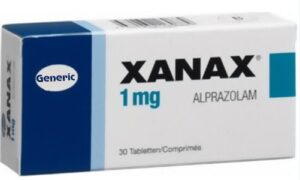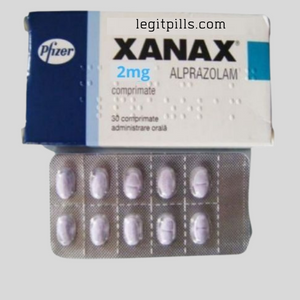Buy Xanax Online -Your Trusted Pharmacy Source
Dealing with anxiety and panic disorders can be an overwhelming challenge. However, there is hope, and one of the medications commonly prescribed for managing these conditions is Xanax (Alprazolam).
In this article, we will explore the benefits, usage, and precautions associated with Xanax, shedding light on the importance of understanding its proper use and potential risks.
Overview of Xanax (Generic)
Xanax, also known by its generic name Alprazolam, belongs to a class of medications called benzodiazepines. Its primary purpose is to provide relief from anxiety and panic disorders by acting on the central nervous system, specifically the brain and nerves.
Xanax achieves this by enhancing the effects of a natural chemical in our bodies known as GABA, ultimately inducing a calming effect.
How to Use Xanax (Generic)?
Proper usage of Xanax is crucial for both its effectiveness and safety. Before starting your Xanax regimen, it’s essential to read the Medication Guide provided by your pharmacist.

Any questions or concerns you have should be addressed by your doctor or pharmacist. Xanax should be taken orally, precisely as directed by your healthcare provider. Dosage is determined by factors such as your medical condition, age, and response to the treatment.
Your doctor may gradually increase your dose until the medication begins to work effectively, so it’s vital to closely follow their instructions to minimize the risk of side effects.
Abruptly stopping Xanax can lead to withdrawal symptoms, including seizures. To avoid this, your doctor may gradually reduce your dose if it becomes necessary to discontinue the medication.
It’s crucial to be aware that Xanax does carry a risk of addiction, particularly if you have a history of substance use disorder. Taking Xanax exactly as prescribed is vital to mitigate this risk. If you find that the medication is no longer effective over time, it’s essential to discuss this with your doctor.
Your doctor should also be informed if your condition persists or worsens while using Xanax. This open communication is vital to ensure you receive the appropriate care and adjustments to your treatment plan. Understanding the proper usage of Xanax is the first step towards managing anxiety and panic disorders effectively.
Xanax Side Effects:
Xanax (Alprazolam) can be a valuable tool in managing anxiety and panic disorders, but like any medication, it comes with potential side effects. It’s essential to be aware of these side effects to ensure a safe and effective treatment experience.
Common side effects of Xanax may include drowsiness, dizziness, increased saliva production, and changes in sex drive or ability. While these effects are generally mild, it’s crucial to inform your doctor or pharmacist if they persist or worsen.
To minimize dizziness and lightheadedness, it’s advisable to rise slowly from a seated or lying position, especially when starting Xanax.
It’s important to remember that your healthcare provider has prescribed Xanax because they believe the benefits outweigh the risks of side effects. Many individuals using Xanax do not experience severe side effects.
However, you should contact your doctor right away if you encounter any unlikely but serious side effects, such as mental or mood changes (such as hallucinations or thoughts of suicide), slurred speech, difficulty talking, loss of coordination, trouble walking, or memory problems.
While rare, some very serious side effects may occur, including yellowing of the eyes or skin and seizures. In the event of any symptoms suggesting a serious allergic reaction, such as rash, itching, swelling (especially of the face, tongue, or throat), severe dizziness, or trouble breathing, seek medical help immediately.
It’s important to note that this is not an exhaustive list of possible side effects. If you notice any other effects not mentioned here, do not hesitate to contact your doctor or pharmacist.
Additionally, in the United States, you can report side effects to the FDA at 1-800-FDA-1088 or at www.fda.gov/medwatch, and in Canada, you can report them to Health Canada at 1-866-234-2345.
Warnings & Precautions
Before starting a Xanax (Alprazolam) regimen, there are several critical warnings and precautions you should be aware of to ensure safe and effective treatment:
- Allergies and Inactive Ingredients: Inform your doctor or pharmacist of any allergies you have, including allergies to other benzodiazepines like diazepam or lorazepam. Xanax may contain inactive ingredients that could trigger allergic reactions.
- Medical History Considerations: Disclose your complete medical history, especially if you have severe lung or breathing problems, liver disease, kidney disease, or a personal or family history of substance use disorder, such as addiction to drugs or alcohol. Additionally, inform your healthcare provider if you have glaucoma.
- Caution with Alcohol, Marijuana, and Driving: Xanax can cause drowsiness and dizziness, and consuming alcohol or marijuana (cannabis) can intensify these effects. It’s essential to avoid activities that require alertness, such as driving or operating machinery, until you can do so safely.
- Pre-surgery Considerations: Before undergoing surgery, inform your doctor or dentist about all the products you use, including prescription drugs, nonprescription drugs, and herbal products. This is crucial because Xanax can interact with other medications used during surgical procedures.
- Pregnancy and Breastfeeding Precautions: Xanax is not recommended during pregnancy due to potential harm to the unborn baby. Consult your doctor for alternative options if you are pregnant. Furthermore, Xanax can pass into breast milk and may have undesirable effects on a nursing infant, so breastfeeding while using this medication is not recommended. Always consult your doctor before breastfeeding while on Xanax.
- Sensitivity in Older Adults: Older adults may be more sensitive to the side effects of Xanax, particularly loss of coordination and drowsiness. These side effects can increase the risk of falling, so it’s essential for older patients to be cautious.
Understanding these warnings and precautions is crucial for ensuring that Xanax is used safely and effectively to manage anxiety and panic disorders. Always consult with your healthcare provider for personalized guidance based on your unique medical history and circumstances.
Xanax Storage and Disposal:
Proper storage and disposal of Xanax (Alprazolam) are important aspects of medication safety. Here’s what you need to know:
- Proper Storage: Store Xanax at room temperature away from light and moisture. Avoid storing it in the bathroom, as humidity can affect its quality. Ensure that all medications, including Xanax, are kept out of the reach of children and pets.
- Disposal Guidelines: Do not flush Xanax down the toilet or pour it into a drain unless specifically instructed to do so. When Xanax is expired or no longer needed, it should be disposed of properly. Consult your pharmacist or a local waste disposal company for guidance on safe disposal methods.
By following these storage and disposal guidelines, you can help ensure the safe and effective use of Xanax while minimizing the risk of accidental exposure to others, especially children and pets.
Drug Interactions:
Understanding potential drug interactions is crucial when taking Xanax (Alprazolam) to ensure both the medication’s effectiveness and your safety. Here are some key points regarding drug interactions:
- Comprehensive Medication List: Maintain a complete list of all the products you use, including prescription drugs, nonprescription drugs, and herbal products. Share this list with your doctor and pharmacist to identify potential interactions effectively.
- Doctor’s Approval: Never start, stop, or alter the dosage of any medicines without consulting your doctor. Your healthcare provider can assess potential interactions and make necessary adjustments to your treatment plan.
- Specific Drug Interactions: Xanax may interact with various substances, including:
- Kava
- Sodium oxybate
- Azole antifungals (e.g., itraconazole, ketoconazole)
- Cimetidine
- Certain anti-depressants (e.g., fluoxetine, fluvoxamine, nefazodone)
- HIV medications (e.g., delavirdine, protease inhibitors like indinavir)
- Macrolide antibiotics (e.g., erythromycin)
- Rifamycins (e.g., rifabutin)
- St. John’s wort
- Medications for seizures (e.g., phenytoin)
- Caution with Other Sedatives: Xanax may interact with products that cause drowsiness or breathing problems, such as opioid pain relievers, cough medications (e.g., codeine, hydrocodone), alcohol, marijuana (cannabis), other drugs used for sleep or anxiety (e.g., diazepam, lorazepam, zolpidem), muscle relaxants (e.g., carisoprodol, cyclobenzaprine), and antihistamines (e.g., cetirizine, diphenhydramine).
- Check Labels: Be vigilant when using over-the-counter medicines like allergy or cough-and-cold products, as they may contain ingredients that cause drowsiness. Consult your pharmacist about safely using these products in combination with Xanax.
- Smoking and Xanax: Inform your doctor if you smoke or have recently quit smoking, as cigarette smoking can affect the blood levels of Xanax, potentially necessitating adjustments to your dosage.
Understanding these potential drug interactions and communicating openly with your healthcare provider is vital to ensure that Xanax is used safely and effectively as part of your treatment plan.
Overdose:
While Xanax (Alprazolam) can be beneficial in managing anxiety and panic disorders, it’s crucial to be aware of the risk of overdose and how to respond in case of an overdose situation:
- Recognizing Overdose Symptoms: An overdose of Xanax can lead to serious symptoms such as passing out or trouble breathing. If you or someone else experiences severe symptoms like severe drowsiness, slowed reflexes, slowed breathing, or loss of consciousness, seek immediate medical attention.
- Emergency Contact: In the United States, you can call 911 for emergency medical assistance if someone has overdosed on Xanax. In Canada, contact a provincial poison control center.
It’s essential never to take more Xanax than prescribed and to store your medication securely to prevent accidental ingestion by others, especially children.
Missed Doses and Notes:
Managing your Xanax (Alprazolam) medication effectively also involves understanding how to handle missed doses and some additional important notes:
- Missed Doses: If you miss a dose, take it as soon as you remember. However, if it’s close to the time for your next scheduled dose, skip the missed dose and take the next one at the regular time. Do not double your dose to catch up, as this can increase the risk of side effects or overdose.
- Legal Considerations: Do not share your Xanax medication with others, as sharing prescription medication is against the law and can pose risks to those it was not prescribed for.
- Medical Monitoring: Depending on your medical history and specific circumstances, your doctor may recommend periodic laboratory and/or medical tests, such as liver function tests, to monitor your progress and check for potential side effects. Regular monitoring is an essential part of managing your treatment effectively.
By adhering to these guidelines regarding missed doses and other important notes, you can ensure that your Xanax treatment remains safe and effective throughout your journey to managing anxiety and panic disorders. Always consult your healthcare provider for personalized advice and recommendations based on your unique needs.
Conclusion
In conclusion, Xanax (Alprazolam) is a valuable medication for managing anxiety and panic disorders. Understanding its benefits, proper usage, and precautions is paramount for a safe and effective treatment experience.
Xanax can provide much-needed relief, but it also carries potential side effects and risks, especially regarding addiction and withdrawal. Open communication with your healthcare provider is essential throughout your Xanax journey to address any concerns or adjustments needed for your unique medical history and circumstances.
Additionally, proper storage, disposal, and awareness of drug interactions, overdose symptoms, and missed doses are crucial for responsible medication management.
By staying informed and seeking professional guidance, you can use Xanax as a tool to regain control over your anxiety and lead a more fulfilling life.
FAQs (Frequently Asked Questions)
Can I Buy Xanax Online Without a Prescription?
No, it is illegal and unsafe to buy Xanax (Alprazolam) online without a valid prescription from a licensed healthcare provider. Purchasing prescription medications without a prescription is against the law and can pose serious health risks.
Where Can I Buy Xanax Online Legally?
You can legally obtain Xanax online by consulting a licensed healthcare provider who can evaluate your medical condition and prescribe the medication if deemed appropriate. Utilize reputable online pharmacies that require a valid prescription and operate within the legal framework.
What Are the Common Side Effects of Xanax?
Common side effects of Xanax include drowsiness, dizziness, increased saliva production, and changes in sex drive or ability. These effects are generally mild and may improve over time. However, if they persist or worsen, consult your healthcare provider.
Can Xanax Lead to Addiction?
Yes, Xanax carries a risk of addiction, especially when used in high doses or for extended periods. It’s crucial to take Xanax exactly as prescribed by your doctor to minimize this risk. If you have a history of substance use disorder, inform your healthcare provider before starting Xanax.
What Should I Do If I Miss a Dose of Xanax?
If you miss a dose of Xanax, take it as soon as you remember. However, if it’s close to the time for your next scheduled dose, skip the missed dose and take the next one at the regular time. Do not double the dose to catch up, as this can increase the risk of side effects or overdose.
How Should Xanax Be Stored and Disposed Of?
Store Xanax at room temperature, away from light and moisture. Keep it out of the reach of children and pets. Do not flush Xanax down the toilet or pour it into a drain. Properly dispose of expired or unneeded medication by consulting your pharmacist or local waste disposal guidelines.
What Are the Potential Drug Interactions with Xanax?
Xanax can interact with various medications and substances, including some antifungals, anti-depressants, HIV medications, antibiotics, and more. Always maintain a comprehensive list of all the products you use and share it with your healthcare provider to identify and manage potential interactions effectively.
How Can I Recognize an Overdose of Xanax, and What Should I Do?
Symptoms of a Xanax overdose may include severe drowsiness, slowed reflexes, slowed breathing, or loss of consciousness. If you or someone else experiences these symptoms, seek immediate medical assistance by calling 911 in the United States or contacting a provincial poison control center in Canada.
Is Xanax Safe During Pregnancy and Breastfeeding?
Xanax is not recommended during pregnancy due to potential harm to the unborn baby. Consult your doctor for alternative options if you are pregnant.
Xanax can also pass into breast milk and may have undesirable effects on a nursing infant, so breastfeeding while using this drug is not recommended. Always consult your doctor before breastfeeding while on Xanax.


